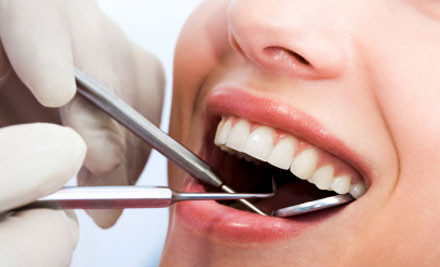Comprehensive Dental Exam
Comprehensive Dental Exam : Here, at Old Hook Dental, our exams are very thorough aided by using the latest technology. While there is no substitute for a trained pair of eyes, a mirror and explorer, there are things that are physically impossible to detect without other aids and we have them all: digital X-rays, panoramic X-rays, intra-oral cameras and computerized record keeping allow you to see for yourself exactly what is going on in your mouth right along side Dr. Aurbach. With that being said, the biggest, most important factor in maintaining your oral health for you and your family is YOU. Keeping regular exam and hygiene appointments is probably the second biggest factor in staying healthy. As dentists, we see you (hopefully) twice a year, you are on guard duty to protect your oral health with proper brushing and flossing for the other 363 days (of course we are always here to help if problems arise and you need to call for backup).

What is a dental exam?
A dental exam is comprised of several different aspects, looking at different things; think of it like you were purchasing a house - you wouldn't buy it just because it looks pretty, you'd also inspect the foundation, electrical, plumbing, roof, etc... As dentists, we don't just make teeth look pretty, we make sure your periodontal (gum) health is good, there are no signs of decay or disease. Each part of the dental exam helps to ensure that you and your dentist understand what is going on with your oral health. In order to better describe a routine dental exam, we’ve divided it into 9 parts:
- Introduction - Dentistry is a tough and stressful job, people are, at times, uncomfortable and in pain, or just frightened at the mere mention of us. Despite the stigma, we are not horrible monsters with hairy knuckles, glasses, a receding hairline (and probably with horns and a tail). We are people just like you, we are here to help and we introduce ourselves in the hopes of getting to know a little about you and helping put you at ease.
- Your needs - Second, we want to know how we can help you today? What are your dental needs, expectations and what kind of work would you like to have done?
- Medical History - We obtain a very detailed health history by reviewing with you the papers you filled out in the hopes of getting a better understanding of you as a patient. This includes: any medications you may be taking, past or current medical conditions, any surgeries you may have had and checking your blood pressure. Getting an accurate health history is super important to ensure that there are no systemic problems that will affect the dental treatment or your overall health.
- Dental Risks - Risk factors give us information about things we may not be able to see or diagnose. Drinking large quantities of soda or sugar drinks will increase your risk for decay, smoking can increase risks for periodontal disease and cancers, playing sports can increase risk for traumatic injuries. Again, it is all part of getting a better understanding of you as a patient.
- Extra-oral (head, neck and TMJ) - During the extra-oral exam, we are checking for anything that does not belong. The neck and underside of the chin is palpated for any enlarged lymph nodes or lumps that could be suspicious. The TMJ is palpated by opening and closing, noting any clicking, popping or pain.
- Intra-oral (tongue, lips, cheeks, gums, throat, soft tissues of the mouth) - During the intra-oral soft tissue exam, we look at the areas inside your mouth. This includes: all areas of the tongue and floor of the mouth, inside of the lips, cheeks, gums, hard and soft palate, throat and tonsils. We are checking for signs of disease and infection such as oral cancers, ulcers, dental infections, swelling and anything else that doesn't belong.
- Teeth - Once the big picture has been established, we zoom in a bit more. Next comes an examination of the teeth. We are looking at existing fillings, crowns, cavities, fractures, chips, missing teeth, root canals, implants and how you bite to make sure all of your current dental work is still functioning. If there are any areas of concern we will address those with you. If you are a new patient or any trouble areas are detected, X-rays will be taken.
- Periodontal exam - A periodontal exam tests the health of your gums and bone which is vital to the support your teeth. The exam consists of periodontal probing where we place a thin measuring device in the periodontal pocket space between your teeth and your gums to check the support levels (Click here for more information on Periodontal Disease). Deep pockets indicate an issue that will require some form of intervention, as no amount of brushing or flossing will be able to clean far enough down in the area; leading to progression of the disease and eventual loss of teeth.
- Treatment plan and consent - With all the information that we have collected a treatment plan is created unique to you. This is our guide or plan of action to restore your mouth to a healthy state, as well as options for alternative treatments that may be better suited for you. At Old Hook Dental, we will discuss with you all of your available options as well as the course of treatment, cost, maintenance and results you can expect so you can choose what best suits your goals, needs and desires.